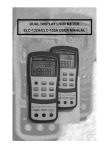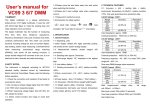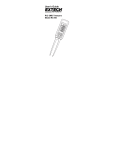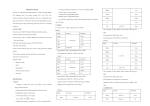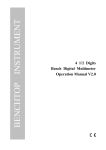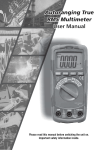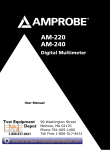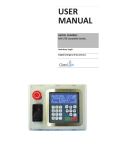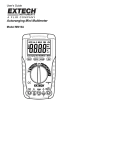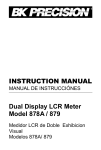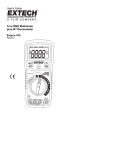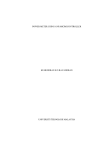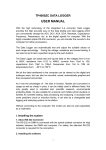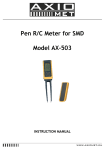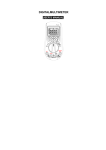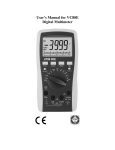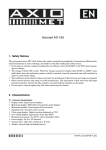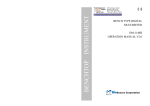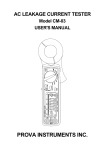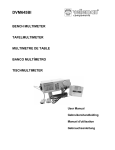Download DIGITAL MULTIMETER INSTRUCTION MANUAL
Transcript
DIGITAL MULTIMETER INSTRUCTION MANUAL 1. SUMMARY This 3 3/4 digital multimeter with highly stable performance is driven by 2 pieces 1.5V battery. It 40V 10 mV 40kΩ 10Ω 400V 100 mV 400kΩ 100Ω 1000V ±(1.0%+4) 1V 4MΩ uses a LCD with 32mm high figure, which makes the reading clearer and the operation more Input impedance: at 400mv range >40MΩ, at other ranges is 10MΩ. convenient. Overload protection: 1000V DC or 750V AC peak value The digital multimeter holds functions of measuring DCV, ACV, DCA, ACA, resistance, capacitance, 3.2.3 AC Voltage(ACV) 1kΩ 40MΩ ±(1.2%+5) 10kΩ Open circuit voltage: 400mV. Overload protection: 250V DC/AC peak value frequency, temperature, duty cycle, transistor, diode, and continuity, etc. It also can provide special Range Accuracy Resolution NOTE: At 400Ω range, short the test leads first to measure the wire resistance and then functions including unit symbol display, data holding, relative value measuring, auto/manual range 400mV ±(1.5%+6) 0.1mV subtracts it from the real measurement. Or press “REL” to clear the wire resistance and read the 1 mV value directly. ±(0.8%+6) 10 mV 3.2.7 Capacitance(C) 100 mV Range Accuracy 1V 4nF ±(2.5%+6) switching (RANGE), auto power off and warning alarm. To assure high accuracy and resolution, it 4V adopts an 4-bit microprocessor and a dual integral A/D conversion IC as its core which can drive 40V LCD directly. It is an ideal tool for labs, factories and radio-technology. 400V 2. 750V SAFETY PRECAUTIONS ±(1.0%+6) The instrument is designed according to IEC1010 standard (safety standard issued by International Input impedance: at 400mv range >40MΩ, at other ranges is 10MΩ. 40nF Electro technical Committee). Please read the following before operation. Overload protection: 1000V DC or 750V AC peak value 400nF 2.1 Check the connection and insulation of test leads to avoid electric shock. Frequency response: at 750V range: 40~100Hz, at other ranges: 40~400Hz 2.2 To avoid electric shock and damage to the meter, do not input voltage higher than DC 1000V or Displaying: sine wave RMS (average value response) 40μF AC 750V during measurement. 3.2.4 DC Current(DCA) 200μF 2.3 When measuring voltage higher than DC 60V or AC 40V, please be careful. 2.4 Select correct function and range to avoid fault operation. 2.5 Please move the test leads away from test points when switching the function. 2.6 Please don’t input voltage in current terminal. 2.7 Please don’t modify the circuit arbitrarily, it may cause safety problem. 2.8 Introduction for safety symbols: “ “ ” exists high voltage, “ ” GND, “ ” dual insulation, “ ” Operator must refer to manual, ” Low battery indication. Range Accuracy Resolution Resolution 1pF 10pF 100pF ±(3.5%+8) 4μF 1nF 10nF ±(5.0%+8) 100nF Overload protection: 250V DC/AC peak value 400uA 0.1μA WARNING: Do not input any voltage at this range! The capacitor must be completely 4000uA 1μA discharged before making measurement. When measuring in line capacitor, make sure the 10μA power is cut off before testing. 400mA 100μA 3.2.8 Frequency(F) 4A 1mA Range 10mA 10Hz 0.001Hz 0.01Hz 40mA 20A ±(1.0%+5) ±(2.0%+5) Accuracy Resolution Maximum voltage drop: 400mV for mA range, and 200mV for A range 100Hz 3.1 General Characteristics Maximum input current: 20A (for 15 seconds). 1000Hz 3.1.1 Display: LCD; Over load protection: 0.5A/250V fast action fuse and 13A/250V fast action fuse. 10kHz 3.1.2 Max display: 4000 (3 3/4) digits, automatic polarity and unit symbol display; 3.2.5 AC Current(ACA) 100kHz 10Hz 3. FEATURES 3.1.3 Measurement method: double integral A/D conversion; Range 3.1.4 Sampling rate: approx.3 times/sec. 3.1.5 Over-range display: “OL” displayed in the highest digit. 3.1.6 Low battery display: “ ” 3.1.7 Working environment: (0~40)℃, relative humidity: <80%; 3.1.8 Store condition: (-10~50)℃, relative humidity: <80% 3.1.9 Power supply: 2pcs 1.5V battery (“AAA”7# battery); 3.1.10 Dimension: 185×93×35mm (length*width*height); Resolution 1MHz 100Hz 0.1μA 30MHz 1kHz 4000uA 1μA Input sensitivity: 0.7V. ±(1.5%+5) 10μA Overload protection: 250V DC/AC peak value. 400mA 100μA 3.2.9 Transistor (hFE) 4A 1mA 20A 3.1.11 Weight: approx. 290g (including battery); ±(2.0%+10) 10mA 3.1.12 Accessories: test leads, user manual, TP01 temperature probe, gift box, and 2*1.5V batteries. Maximum voltage drop: 400mV for mA range, and 200mV for A range 3.2 Technical Features Maximum input current: 20A (for 15 seconds). 3.2.1 Accuracy: ± (a% × reading data + digits). To assure accuracy, the environment temperature Over load protection: 0.5A/250V fast action fuse and 13A/250V fast action fuse. should be (23±5) ℃, relative humidity should <75%. One year guarantee since production date. Frequency response: 40~100Hz under 10A range, 40~400Hz at other ranges. 3.2.2 DC Voltage(DCV) 3.2.6 Resistance(Ω) Range 400mV 4V Accuracy ±(0.5%+4) 1Hz 400uA 40mA Accuracy 0.1Hz ±(0.5%+4) Measurement Range hFE NPN or PNP 0~1000 Test conditions Base current is approx 15uA, Vce is about 4.5V 3.2.10 Diode and Continuity Test Range Description Test Conditions Forward DC current is Diode forward voltage drop approx 0.5mA, reverse Resolution Range Accuracy Resolution 0.1mV 400Ω ±(0.8%+5) 0.1Ω When the resistance under test is Open circuit voltage: 1 mV 4kΩ ±(0.8%+1) 1Ω less than 70±10Ω, buzzer sounds 0.5V voltage is approx 1.5V. NOTE: Current higher than that will damage the fuse, and may cause damage to the circuit of meter. Overload protection: 250V DC/AC peak value 1. Under manual range mode, if LCD displays “OL”, it means over range, you should select 4.6 Resistance measurement WARNING: Do not input any voltage at this range. the higher range. 4.6.1 Insert the black lest lead into “COM” terminal and the red one into “V/Ω/Hz” terminal. 3.2.11 Temperature(℃) 2. Do not input a voltage over DC 1000V. It may cause damage to the circuit of meter. 4.6.2 Switch the knob to Ω range, and connect the leads with the resistor under test. 3. Be careful while measuring a high voltage circuit. DO NOT touch the high voltage circuit. 4.6.3 Press “RANGE” key to choose auto or manual range. 4. The built –in buzzer will beep to warn user, when the measuring voltage over DC1000V. 4.6.4 Before measuring low resistance, you should make the test leads short-circuit at first, 4.3 ACV measurement and then press “REL”. By this way, you can get the actual value of the resistance. Thermocouple: K type 4.3.1 Insert the black test lead into “COM” terminal, and the red one into “V/Ω/Hz” terminal. Note: WARNING: do not input any voltage at this range. 4.3.2 Switch the knob to V range, and press “DC/AC” key to choose AC mode; 1. Firstly users should select the highest range, if the value of resistance is unknown 4. 4.3.3 Auto range is the original states, it will display “AUTO” symbol. Press “RANGE” key to beforehand, and then select the proper range based on displaying value. 4.1 Panel Description change to manual range mode, and 400mV, 4V, 40V, 400V, 750V range is selectable; 2. The LCD displays “OL” when the resistance is over the selected range. The knob should be ① LCD: display the measuring value and unit. 4.3.4 Connect test leads to the test point; LCD will display voltage of the two test points. adjusted to a higher range. When measuring value is over 1MΩ, the reading will take a few ② Function key: Note: seconds to be stable. It’s normal for high resistance measurement. ②-1. RST key: when the meter under sleep or lock states, 1. At 400mV range there is only manual range available. 3. When input terminal is in open circuit, LCD will display “OL”. press this key, the meter will be active. 2. Under manual range mode, if LCD displays “OL”, it means over range, you should select 4. Before measuring in line resistor, make sure that the power is off and all capacitors are ② -2. Hz/DUTY key: when measuring the AC the higher range. discharged completely. voltage/current, 3. Do not input a voltage over AC 750V. It may cause damage to the circuit of meter. 5. When there is big error, it may be affected by other online component or there is voltage on continuously. Range Accuracy Resolution <400℃ ±(0.8%+4) -40℃-1000℃ ≥400℃±(1.5%+15) 1℃ OPERATION press Hz/DUTY can choose voltage/frequency/duty cycle or current/frequency/duty 4. Be careful while measuring a high voltage circuit. DO NOT touch the high voltage circuit. the resistor. cycle mode. When measuring the Frequency, press 5. The built –in buzzer will beep to warn user, when the measuring voltage over AC750V. 6. Do not input any voltage at resistance range. Hz/DUTY will shift between frequency and duty cycle 4.4 DCA measurement 4.7 Capacitance measurement (1~99%) measurement. 4.4.1 Insert the black test lead into “COM” terminal and the red one into “mA” terminal (Max. 4.7.1 Switch the knob to “ ②-3. REL key: press it to store the present reading as a reference for subsequent readings. The 400mA) or into “A” terminal (Max.20A); 4.7.2 Insert the black test lead to “COM” terminal and the red one to “V/Ω/Hz” terminal; display is zeroed, and the stored reading is subtracted from all subsequent readings and REL symbol 4.4.2 Switch the knob to a proper current range, and then connect the test leads to the electric 4.7.3 If the LCD doesn’t display “0”, press “REL” to clear the reading; appears. REL (readings) = input value - reference value. Press it again to exit the REL mode and circuit. LCD will display polarity and current of the test point connected by the red test lead. 4.7.4 Connect the capacitor to “COM” and “VΩHz” terminal. (Note: the red test lead is for “REL” symbol will disappear. Note: positive pole+).LCD ○ displays capacitance value. ②-4. HOLD key: press the key, the measuring value will be held on LCD and HOLD symbol 1. Firstly users should select the highest range, if users not sure about the range of current Note: appears. Press it again to exit the hold mode and HOLD symbol will disappear. under test, and then select the proper range based on displaying value. 1. Don’t input voltage or current to the “VΩHz” terminal when measuring the capacitance or ②-5. RANGE key: auto range is the default when you turn on the meter. Press RANGE it will enter 2. If the LCD displays “OL”, it means the current is over range. Now you need to select a manual range mode. Under manual range mode, press RANGE each time will select a higher range higher range. till reach the highest range then back to the lowest range. Press RANGE for 2 seconds it will back to 3. When tested current ≥10A at 20A range, buzzer will sound to remind user. auto range mode. 4. Maximum input current is 400mA or 20A (subject to where the red test lead insert into). ②-6. DC/AC key: select DC/AC mode. Current higher than that will damage the fuse, and may cause damage to the circuit of meter. ③ Input terminal for hFE measurement 4.5 ACA measurement ④ Rotary switch: used to change the range and choose functions. 4.5.1 Insert the black test lead into “COM” terminal and the red one into “mA” terminal (Max. ⑤ Input terminal for temperature measurement. 600mA) or into “A” terminal (Max.20A); ⑥ Voltage, current, resistance, frequency input terminal. 4.5.2 Switch the knob to a proper current range, press “DC/AC” key to select the AC mode, ⑦ Battery case. and then connect the test leads to the electric circuit. LCD will display current value. 4.2 DCV measurement Note: 4.2.1 Insert the black test lead into “COM” terminal, and the red one into “V/Ω/Hz” terminal. 1. Firstly users should select the highest range, if users not sure about the range of current 4.2.2 Switch the knob to V range. Press DC/AC key to choose DC mode. under test, and then select the proper range based on displaying value. 4.2.3 Auto range is the original states, it will display “AUTO” symbol. Press “RANGE” key to 2. If the LCD displays “OL”, it means the current is over range. Now you need to select a change to manual range mode, and 400mV, 4V, 40V, 400V, 1000V range is selectable; higher range. 4.2.4 Connect test leads to the test point; LCD will display polarity and voltage of the test point 3. When tested current ≥10A at 20A range, buzzer will sound to remind user. connected by the red test lead. 4. Maximum input current is 400mA or 20A (subject to where the red test lead insert into). ”range; the capacitor still in the “Cx” terminal. 2. In order to assure the accuracy, please press “REL” to clear the reading before testing. 3. There is only the auto range mode under the capacitance range. 4. The capacitor must be completely discharged before testing. 5. The reading of 200uF range will take more than 15 seconds to be stable. 4.8 Frequency measurement 4.8.1 Insert the black lest lead into “COM” terminal and the red one into “V/Ω/Hz” terminal. 4.8.2 Switch the knob to “Hz” range, connect the test leads or shielded cable to the signal source or the load which is tested. 4.8.3 Press “Hz/DUTY” key to switch frequency/duty cycle measurement, LCD will display the frequency or duty cycle of the signal source which is tested. Note: 1. There is only the auto range mode under the frequency range; 2. The meter can still work if the input current is higher than 10V rms, but the accuracy is not guaranteed; 3. In noisy environment, it's better use shield cable to measure a low signal; 4. When measuring high voltage circuit, do not touch the high voltage circuit; 5. Don’t input voltage higher than 250V DC or AC peak value, or it may damage the meter. 3. Don’t make any measurements when the battery isn’t installed or the back cover isn’t fixed. 4.9 Transistor hFE measurement 4.9.1 Switch the knob to hFE range; 4.9.2 Define the transistor is NPN or PNP type, then insert the emitter, base and collector separately 4. Before replacing fuse, please remove the test leads from the measuring point and turn off the power. 5. Keep the meter away from water, dust and shock. into the relative hole, the value will be displayed on LCD. 6. Don't expose the meter under high temperature, high humidity, combustible, explosive and 4.10 Diode and Continuity test: strong magnetic place. 4.10.1 Insert the black test lead into “COM” terminal and the red one into “V/Ω/Hz” terminal (the 7. Wipe the case with a damp cloth and detergent. Do not use abrasives and alcohol to clean the meter. polarity of red lead is “+”) range, and press “DC/AC” key to select diode measurement 4.10.2 Switch the knob to 8. If do not operate for a long time, you should take out the battery to avoid mode, and then connect test leads with the diode under testing, leakage damage. 4.10.3 Forward measurement: connect red test lead to the positive polarity and the black test lead to 9. When “ the cathode polarity of the diode. LCD will display the approx. value of forward voltage drop. should replace the battery according to the 4.10.4 Backward measurement: connect red test lead to the cathode polarity and the black test lead following steps: to positive polarity of the diode. LCD will display “OL”. 9-1. Follow picture 2, and remove the 4.10.5 The complete diode testing includes forward and backward measurement, if the result doesn’t holster at first. meet the descriptions above; it means the diode is broken. 9-2.Unlock the battery door and remove 4.10.6 Press “DC/AC” key to select the Continuity measurement mode. 4.10.7 Connect test leads to two points of tested circuit, if the resistance is less than (70±10) Ω, the buzzer sounds. ” symbol is displayed, you the cover; 9-3. Replace the old battery with the new one. For longer using life, it's better to use alkaline battery. 9-4. Fix the battery door. 9-5, Follow the picture to put on the holster. Note: 1. Don’t input voltage at “ ” range. 2. Make sure the power is off and all capacitors are discharged. Any AC signal will make the buzzer sounds. 10. Fuse change: When replacing fuse, please use fuse with same type and specification. 10-1. Follow picture 2, and remove the holster at first, then unlock the battery door and remove the cover; 10-2. Take out the fuse and put on a new one. 4.11 Temperature measurement 10-3. Fix the battery door, and put on the holster. 4.11.1 Switch the knob to “℃” range. 6. 4.11.2 Insert the cold terminal (free end) of thermocouple in “TEMP” socket,and put the working If the meter does not work properly, please check the meter as following steps: terminal (temperature measuring end) of thermocouple on the surface or inside the object to be (If the problems still cannot be solved, please refer to repairing center or contact the local tested. Then you can read temperature from the screen, and the data is in Centigrade. dealers.) TROUBLE SHOOTING Fault Note: 1. If insert the thermocouple oppositely, it will display the wrong value. When the temperature is No reading on LCD rising, the value will be down. 2. When the input terminal is open circuit, it will display the environment temperature. 4. Don’t input voltage at temperature range. Turn on the power Replace battery Replace battery No current or temperature input Replace fuse Big error Value Replace battery signal appears 3. Don’t change the temperature probe randomly, or the accuracy will not be guaranteed. Solution 4.12 Data hold The specifications are subject to changes without prior notice. Press HOLD will enter HOLD mode, the current value will be held on LCD and HOLD symbol will The content of this manual is regarded as correct. If users find out any mistakes or be displayed. Press HOLD again can exit the HOLD mode. 4.13 Auto power off omissions, please kindly contact the manufacturer. The manufacturer will not be responsible for accidents and damage caused by improper 4.13.1 If there is no measurement in 15 minutes, the meter will turn into dormancy mode. 1 minute operations. The functions described in this User Manual shall not be considered as the before the auto power off the built-in buzzer will be sound 5 times. Press any key to restart the reason for any special usages. meter. 4.13.2 Keep “DC/AC” key down when turn on the meter, auto power off function will be canceled. 5. METER MAINTENANCE The meter is a precise instrument. Random changes to the circuit are not allowed. Note: 1. Don’t input the voltage value higher than DC 1000V or AC 750V rms. 2. Don’t input voltage at current, resistance, diode and continuity range.



